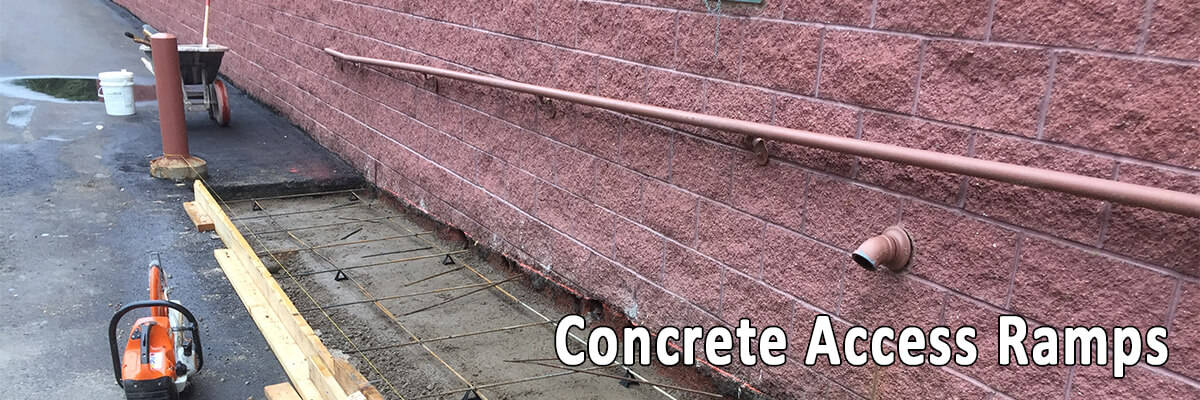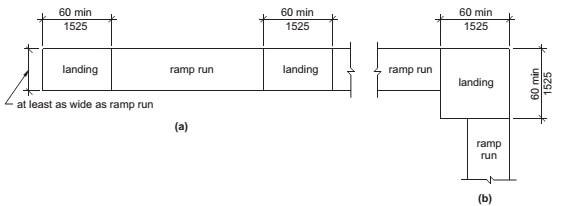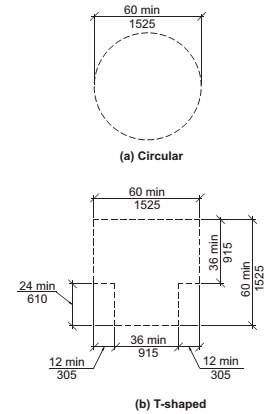We’re continuing our series on ADA Compliant Construction by talking about ramps which comply with the 2010 ADA Standards!

So you need a ramp, huh?
You’ve measured the distance to your ADA Compliant Entry and you and your contractor have determined that in order to comply with the ADA and the Minnesota Accessibility Code you have to put in an ADA compliant ramp. And you want your concrete contractor (since they are already doing your parking lot and walkway) to also make the ramp out of concrete too as part of the deal.
Don’t freak! It’s going to be OK!
The worst thing to do at this point would be to freak out and try to get your contractor to work against the ADA because the idea of installing a ramp for accessibility is daunting. It costs money, yes. Most things do. But if you’ve got a contractor who is as well versed in ADA and the Accessibility Codes as Goodmanson Construction is, you should take their recommendation seriously.
Remember your goal: removing barriers to customers trying to access your business. Sometimes a ramp is the only way to do that. Other times, there might be another solution…
What are the Rules for the Ramp?
There are a lot of rules for a ramp. Oh boy are there a lot of ADA standards for accessible ramps. But you know what that means? It means there are a lot of ways to do it wrong, but very fews ways to do it right. If you have a contractor that knows things like ramp slope requirements and what types of door will work with what accessible entrance, you’re in good shape.
You might want to ask them about this handy table. Now, you don’t need to be an expert on this kind of stuff (like we said in a prior entry, it’s not your job to be the expert) but it always helps to know you’re talking with someone who knows what they are talking about so you at least know you’re being pointed in the right direction.
| SLOPE | MAXIMUM RISE |
| Steeper than 1:10 but not steeper than 1:8 | 3 inches (75 mm) |
| Steeper than 1:12 but not steeper than 1:10 | 6 inches (150 mm) |
This table looks weird but it’s pretty simple to explain. If you’re trying to get up 3 inches in height towards your entry, you can use a slope of 1:10 to 1:8, and if you’re trying to achieve a height rise of 6 inches, you’re going to need to set your slopes from 1:12 to 1:10.
If you think about it from the perspective of people with disabilities in mobility, it makes sense. Try to think of something like a wheelchair trying to power up a wheelchair ramp. Would you call it accessible if that ramp had a slope that required someone to really crank their wheels just to get up so that they are covered in a full flop sweat by the time they get to your front door?
No. I don’t think you would call that accessible. I think you’d still consider that a barrier to entry because that person in a wheelchair may take one look at that entry and say “no thanks!”
Whenever you think about ADA compliance, always think of how someone would actually use the accessibility feature.
Can I avoid putting in an ADA compliant ramp?
This is actually one of the more important questions to ask your contractor. Ramps can get expensive, especially when you consider that if it’s a ramp, it has to have railings. Railings can put a lot of added cost onto the project.
The answer as to whether or not you need an ADA compliant ramp depends on the height of the entry and the amount of space we have to get people up to that entry.
Now, we’re not going to get into specifically what the space you need is, because there aren’t definite specifics for that. But what we can say is that you have enough space for a sidewalk that can switchback (with enough room for landings and turning areas) at a grade of 1:20 or less than 5% slope, guess what? That qualifies as an ADA compliant sidewalk. Not as a ramp.
That means, if you have the space and can reach the height of the entry with no problem with a 1:20 grade, you can actually put in a sidewalk that doesn’t require railings.
That also saves you money on the pour as well, as the contractor won’t need quite as many forms to pour the sides of the ramp. All around, you could be saving money.

But be careful! Make sure you have the room for this kind of project. These kinds of accessible sidewalks, by nature, take up more space than a ramp. Which makes sense: if you’ve got a steeper grade you can cover more height over a shorter distance.

Like we said, sometimes the only thing that will get the job done is an ADA compliant ramp. And if that’s what you’ve got to do, that’s what you’ve got to do!

